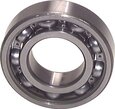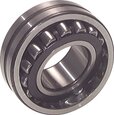An Overview of Thrust Bearings
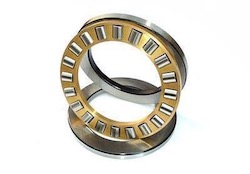
Figure 1: Thrust bearing
Thrust bearings are used to support thrust loads, or axial loads, applied to a shaft. Thrust bearings are divided into several categories: those with ball rolling elements and those with cylindrical elements, single and double direction, and thrust bearings that can support axial and radial loads. This article covers the various types of thrust bearings, their basic design, and their general applications.
Table of contents
- How does a thrust bearing work?
- Thrust bearings types and applications overview
- Thrust ball bearings
- Thrust roller bearings
- Single vs double direction thrust bearings
- Angular thrust ball bearings
- Tapered roller thrust bearings
- Full complement thrust ball bearings
- Thrust needle bearings
- Spherical roller thrust bearing
- FAQs
View our online selection of bearings!
How does a thrust bearing work?
A thrust bearing, also known as an axial thrust bearing, handles axial loads, which are loads parallel to the shaft in a mechanical system. The two main components of a thrust bearing are the bearing housing and the bearing. The housing remains stationary and attached to the machine. The bearing rotates with the shaft.
The bearing, which can be either a ball or cylinderical (roller) shape, is made of metal or plastic. When the shaft receives axial loads, the bearing distributes the load across its surface, which lets the shaft rotate smoothly without excessive friction and wear.
Thrust bearings are relatively simple to maintain due to their detachable design. This means that the individual components can be removed and replaced. Therefore, a thrust bearing can be repaired without replacing the entire bearing.
Thrust bearings are found in various mechanical systems, from automotive engines to industrial machinery and aerospace systems. They are necessary for many high-speed, high-load applications that have axial forces. Learn more about bearings by reading our complete guide to rolling bearings, which also covers the types of loads that bearings work with, including axial ones.
Thrust bearings types and applications overview
Thrust ball bearings and thrust roller bearings overlap in their suitability for applications. Therefore, it can be more complex to determine which bearing is best for an application. To help this, the following table explains different types of bearings, descriptions, and general use cases.
If replacing a bearing in a machine, look in the manufacturer's guide to determine which bearings it uses. Read beyond the table for further explanation of each bearing type.
| Thrust bearing type | Description | General application |
| Thrust ball bearing | Ball-shaped rolling elements | Higher speed but lighter loads than thrust roller bearings. Automotive and some industrial applications. |
| Thrust roller bearing | Cylindrical-shaped rolling elements | Lower speed but higher loads than thrust ball bearings. Mining, construction, and paper mills. |
| Single direction thrust bearing | Basic thrust bearing washer design | Applications with axial loads in a single direction. Pumps and electric motors |
| Double direction thrust bearing | Single shaft washer, but two each of housing washer and ball and cage assembly | Applications with axial loads that frequently change direction. Machine tools and cranes |
| Angular thrust ball bearing | 60° contact angle between rolling elements and raceways | Applications with axial and radial loads. Gearboxes and clutches |
| Tapered roller thrust bearing | Rolling element has a tapered shape | Applications with axial and radial loads. |
| Full complement thrust ball bearing | No cage assembly, so more balls can fit in the washer | Higher axial loads at slower speeds |
| Thrust needle bearing | No raceway in the bearing. Machine walls act as raceway | Very high speeds. Machines with very limited space |
| Spherical roller thrust bearing | Barrel-shaped rollers that can self-align | Heavy axial and moderate radial loads |
Table 1: Thrust bearing descriptions and general applications
Thrust ball bearings
Thrust ball bearings (Figure 2) have balls as their rolling element and are primarily designed to handle axial loads. The rolling ball element allows them to handle higher rotational speeds, but they can't handle high axial loads compared to cylindrical rolling elements.
For more information about ball bearings and how bearings work read our bearing technical article. Our technical library can also help you with information about bearing lubrication, bearing maintenance, and has a wide scope of information on tribology.
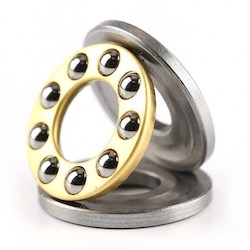
Figure 2: Thrust ball bearing
Thrust roller bearings
Similar to thrust ball bearings, thrust roller bearings (Figure 3) are designed to handle axial loads. Cylindrical roller thrust bearings have cylindrical rolling elements instead of ball-shaped ones. This allows thrust roller bearings to handle heavier axial loads than thrust ball bearings can. However, thrust roller bearings cannot handle as high of speeds as thrust ball bearings.

Figure 3: Single-direction cylindrical thrust roller bearing
Single vs double direction thrust bearings
Whether ball or roller bearings, single direction thrust bearings are suitable for applications with axial loads in one direction, such as pumps and electric motors. Double direction thrust bearings are for applications with axial loads that frequently change direction, such as in machine tools and cranes.
Single direction thrust bearings have a shaft washer, a housing washer, and a ball and cage assembly. Double direction bearings have a shaft washer, and two housing washers and two ball and cage assemblies.
Angular thrust ball bearings
Angular thrust ball bearings are similar to the thrust ball bearings described above. The primary difference is that the contact angle between the balls and the raceways is 60°. This allows these bearings to not only support axial loads, but radial and combined as well. Single direction angular thrust ball bearings (Figure 4 left) handle these loads in one direction, while double direction angular thrust ball bearings (Figure 4 right) handle these loads in two directions.
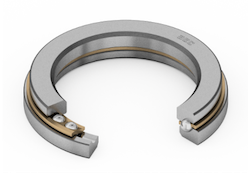
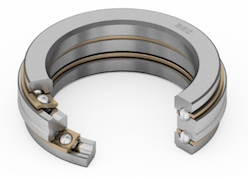
Figure 4: Single direction angular thrust ball bearing (left) and double direction thrust ball bearing (right).
Tapered roller thrust bearings
Tapered roller thrust bearings (Figure 5) can be either single or double direction. They can handle medium and heavy combined radial and axial loads. They have a high carrying capacity for their small cross section, long service life. These qualities make them suitable for various industrial and automotive applications.
As a result of the rollers' tapered shape, the load is evenly distributed between the rollers. In addition, the rollers' shape and design reduce friction and heat generation.
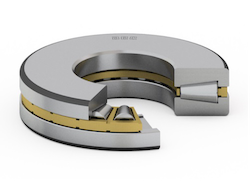
Figure 5: Tapered roller thrust bearing
Full complement thrust ball bearings
Full complement thrust ball bearings (Figure 6) do not have a cage that contains the balls. This allows for more balls to be placed between the raceways. Therefore, full complement thrust ball bearings can handle higher axial loads, but have a lower maximum speed and more rotational torque from ball-to-ball friction.
Because they handle higher axial loads, full complement ball bearings are seen mostly in heavy-duty applications. For example, large cranes, heavy equipment, ship steering equipment, and airplane landing equipment.
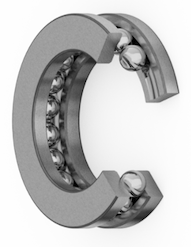
Figure 6: Full complement thrust ball bearing
Thrust needle bearings
For applications with minimal space, such as gear assemblies, needle roller thrust bearings (Figure 7) are ideal. These bearings may or may not have a single raceway; adjacent machine parts can act as raceways for the rolling elements. Thrust needle bearings accommodate axial loads at high speeds.
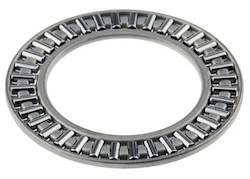
Figure 7: Needle thrust
Spherical roller thrust bearing
Spherical thrust bearings (Figure 8) are widely used in applications involving heavy axial and simultaneous radial loads. They are self-aligning and can accommodate misalignment. Due to their low coefficient of friction, spherical roller thrust bearings require less maintenance.
Due to the cage design and conformity between rollers and washers, these bearings can operate at relatively high speeds. Learn more by reading our guide on spherical roller thrust bearings.
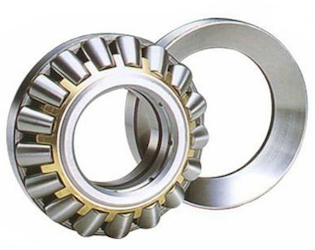
Figure 8: Spherical roller thrust bearing
FAQs
What does a thrust bearing do?
A thrust bearing supports axial loads on a horizontal or vertical shaft.
What's the difference between a thrust and radial bearing?
Basic thrust bearings support axial loads and radial bearings support radial loads.




